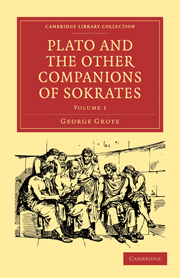Book contents
- Frontmatter
- PREFACE
- Contents
- CHAPTER I SPECULATIVE PHILOSOPHY IN GREECE, BEFORE AND IN THE TIME OF SOKRATES
- CHAPTER II GENERAL REMARKS ON THE EARLIER PHILOSOPHERS—GROWTH OF DIALECTIC—ZENO AND GORGIAS
- CHAPTER III LTFE OF PLATO
- CHAPTER IV PLATONIC CANON, AS RECOGNISED BY THRASYLLUS
- CHAPTER V PLATONIC CANON AS APPRECIATED AND MODIFIED BY MODERN CRITICS
- CHAPTER VI PLATONIC COMPOSITIONS GENERALLY
- CHAPTER VII APOLOGY OP SOKRATES
- CHAPTER VIII KRITON
- CHAPTER IX EUTHYPHRON
- CHAPTER X ALKIBIADES I. AND II.
- CHAPTER XI HIPPIAS MAJOR—HIPPIAS MINOR
- CHAPTER XII HIPPARCHUS—MINOS
- CHAPTER XIII THEAGES
- CHAPTER XIV ERASTÆ OR ANTERASTÆ—RIVALES
- CHAPTER XV ION
- CHAPTER XVI LACHES
- CHAPTER XVII CHARMIDES
- CHAPTER XVIII LYSIS
- CHAPTER XIX EUTHYDEMUS
CHAPTER V - PLATONIC CANON AS APPRECIATED AND MODIFIED BY MODERN CRITICS
Published online by Cambridge University Press: 05 October 2010
- Frontmatter
- PREFACE
- Contents
- CHAPTER I SPECULATIVE PHILOSOPHY IN GREECE, BEFORE AND IN THE TIME OF SOKRATES
- CHAPTER II GENERAL REMARKS ON THE EARLIER PHILOSOPHERS—GROWTH OF DIALECTIC—ZENO AND GORGIAS
- CHAPTER III LTFE OF PLATO
- CHAPTER IV PLATONIC CANON, AS RECOGNISED BY THRASYLLUS
- CHAPTER V PLATONIC CANON AS APPRECIATED AND MODIFIED BY MODERN CRITICS
- CHAPTER VI PLATONIC COMPOSITIONS GENERALLY
- CHAPTER VII APOLOGY OP SOKRATES
- CHAPTER VIII KRITON
- CHAPTER IX EUTHYPHRON
- CHAPTER X ALKIBIADES I. AND II.
- CHAPTER XI HIPPIAS MAJOR—HIPPIAS MINOR
- CHAPTER XII HIPPARCHUS—MINOS
- CHAPTER XIII THEAGES
- CHAPTER XIV ERASTÆ OR ANTERASTÆ—RIVALES
- CHAPTER XV ION
- CHAPTER XVI LACHES
- CHAPTER XVII CHARMIDES
- CHAPTER XVIII LYSIS
- CHAPTER XIX EUTHYDEMUS
Summary
The Canon of Thrasyllus continued to be generally acknowledged, by the Neo-Platonists, as well as by Ficinus and the succeeding critics after the revival of learning
The Platonic Canon established by Thrasyllus maintained its authority until the close of the last century, in regard to the distinction between what was genuine and spurious. The distribution indeed did not continue to be approved: the Tetralogies were neglected, and the order of the dialogues varied: moreover, doubts were intimated about Kleitophon and Epinomis. But nothing was positively removed from, or positively added to, the total recognised by Thrasyllus. The Neo-Platonists (from the close of the second century B.C., down to the beginning of the sixth century) introduced a new, mystic, and theological interpretation, which often totally changed and falsified Plato's meaning. Their principles of interpretation would have been strange and unintelligible to the rhetors Thrasyllus and Dionysius of Halikarnassus—or to the Platonic philosopher Charmadas, who expounded Plato to Marcus Crassus at Athens. But they still continued to look for Plato in the nine Tetralogies of Thrasyllus, in each and all of them. So also continued Ficinus, who, during the last half of the fifteenth century, did so much to revive in the modern world the study of Plato. He revived along with it the neo-platonic interpretation. The Argumenta, prefixed to the different dialogues by Ficinus, are remarkable, as showing what an ingenious student, interpreting in that spirit, discovered in them.
But the scholars of the sixteenth, seventeenth, and eighteenth centuries, speaking generally—though not neglecting wherever they could find it, a more literal interpretation of the Platonic text, correctly presented and improved. The next great edition of the works of Plato was published by Serranus and Stephens, in the latter portion of the sixteenth century.
- Type
- Chapter
- Information
- Plato and the Other Companions of Sokrates , pp. 170 - 211Publisher: Cambridge University PressPrint publication year: 2010First published in: 1865



